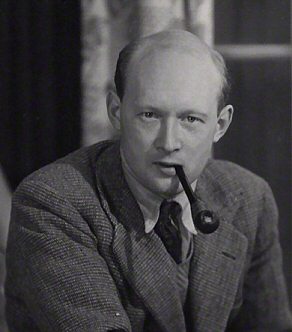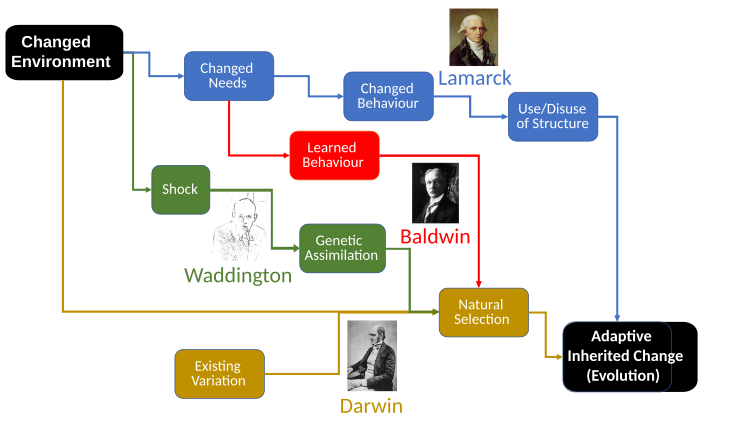C. H. Waddington facts for kids
Quick facts for kids
Conrad Hal Waddington
|
|
|---|---|

Conrad Hal Waddington in 1934
|
|
| Born | 8 November 1905 Evesham, Worcestershire, England
|
| Died | September 26, 1975 (aged 69) Edinburgh, Scotland
|
| Alma mater | University of Cambridge |
| Known for | Epigenetic landscape, canalisation, genetic assimilation, creode |
| Spouse(s) | Justin Blanco White |
| Children | 3, including Caroline Humphrey and Dusa McDuff |
| Awards | Mendel Medal (1960) |
| Scientific career | |
| Fields | Developmental biology, genetics, paleontology |
| Institutions | University of Edinburgh University of Cambridge, Christ's College Wesleyan University Centre for Human Ecology |
| Doctoral students | Robert Edwards |
Conrad Hal Waddington (8 November 1905 – 26 September 1975) was a British scientist who studied how living things grow and develop. He was a developmental biologist, a geneticist (someone who studies genes), and a paleontologist (someone who studies fossils).
Waddington helped create important ideas in biology. These include systems biology, which looks at how all parts of a living system work together, and epigenetics, which studies how genes are turned on or off without changing the DNA itself. He also contributed to evolutionary developmental biology, which explores how development influences evolution.
One of his main ideas was called genetic assimilation. This theory suggested that traits an animal develops because of its environment could become part of its inherited traits over many generations. Some other scientists, like Theodosius Dobzhansky and Ernst Mayr, thought this idea was similar to Lamarckism. Lamarckism was an older idea that said traits gained during an animal's life could be passed on directly to its offspring. Waddington, however, explained his ideas using Darwinian principles.
Waddington was also interested in many other things, like poetry and painting. He believed that science should help society and even wrote about how science could be used for planning in society.
Contents
Life Story of Conrad Waddington
Conrad Waddington, known as "Wad" to his friends, was born in Evesham, England, on November 8, 1905.
When he was very young, he lived in India because his father worked on a tea farm there. At age four, he moved back to England to live with his family, including his grandmother. His parents stayed in India until 1928.
- Early Interests: As a child, Waddington was very close to a local pharmacist, Dr. Doeg. Dr. Doeg, whom Waddington called "Grandpa," introduced him to many sciences, from chemistry to geology. This early learning helped him appreciate how different parts of nature are connected.
He went to Clifton College and then to Sidney Sussex College, Cambridge University. He first studied geology but soon became interested in how living things inherit traits and develop. He also studied philosophy.
- World War II Role: During World War II, Waddington used his scientific skills to help the Royal Air Force. He worked on "operational research," which means using science to solve practical problems in war.
After the war, in 1947, he became a professor at the University of Edinburgh in Scotland. He stayed there for most of his life, continuing his important research.
Conrad Waddington passed away in Edinburgh on September 26, 1975.
Waddington's Family
Conrad Waddington was married twice. From his first marriage, he had a son named C. Jake Waddington, who later became a physics professor.
He then married Margaret Justin Blanco White. They had two daughters:
- Caroline Humphrey, who became an anthropologist (someone who studies human societies and cultures).
- Dusa McDuff, who became a mathematician.
Waddington's Ideas on Evolution and Development
In the 1930s, Waddington became very interested in how living things develop from a single cell. He visited Thomas Hunt Morgan's lab in California, where they studied fruit flies (Drosophila). At that time, many scientists didn't think genes were very important for development, but Waddington believed they were key.
He developed ideas about how genes control development. He studied how changes in genes (mutations) affected the development of the fruit fly wing. He also wrote one of the first textbooks on "developmental epigenetics," which was about how genes affect the visible traits of an organism.
What is Canalisation?
Waddington introduced the idea of canalisation. This is like a built-in stability that helps an organism develop normally, even if there are small changes in its genes or environment. It's why most people have five fingers, even with slight differences in their DNA or surroundings.
What is the Epigenetic Landscape?
Waddington's epigenetic landscape is a famous way to explain how genes guide development. Imagine a marble rolling down a hilly surface with many valleys and paths.
- The marble represents a developing biological cell.
- The hills and valleys represent the different paths a cell can take as it grows and specializes.
- The lowest points in the valleys are the final cell types, like a muscle cell or a nerve cell.
- Waddington called these stable developmental paths "chreodes." He showed that gene changes could affect this landscape, changing how cells develop.
What is Genetic Assimilation?

Genetic assimilation is an idea Waddington proposed about how traits that appear due to environmental stress can become inherited.
- He studied fruit flies that developed a certain trait (missing wing veins) when exposed to heat.
- After several generations, he found that some flies started to show this trait even without the heat treatment.
- Waddington suggested that the flies had "assimilated" this trait into their genes. This means that the ability to develop the trait became fixed in the population, even without the environmental trigger.
Debate: Darwinism vs. Lamarckism
Waddington's idea of genetic assimilation caused some debate.
- Some scientists, like Theodosius Dobzhansky and Ernst Mayr, thought it sounded like Lamarckian inheritance. Lamarck believed that traits gained during an organism's life (like a giraffe stretching its neck) could be passed on to its children.
- However, Waddington always explained genetic assimilation using Darwinian evolution principles. He argued that it was a special case of how organisms adapt to their environment.
- He believed that his work showed that evolution was more complex than just simple gene changes. He called for an "extended evolutionary synthesis," meaning a broader understanding of evolution that included how development plays a role.
Waddington as an Organiser and Thinker
Waddington was very active in helping biology grow as a field. He helped create several groups that represented biology as a scientific area.
Many of his colleagues at the University of Edinburgh became famous scientists during his time there. Waddington was a broad thinker who was interested in both art and science. His 1969 book, Behind Appearance, explored the connections between painting and natural sciences.
- Founding the Centre for Human Ecology: In 1972, Waddington founded the Centre for Human Ecology at the University of Edinburgh. This center focused on how humans interact with their environment.
- Institute for Advanced Studies in the Humanities: He also helped start the Institute for Advanced Studies in the Humanities at the University of Edinburgh in 1969. This institute brought together scholars from different fields to discuss important ideas.
Waddington is remembered as one of the most original and important thinkers in developmental biology before the age of molecular biology. The medal of the British Society for Developmental Biology is named after him, honoring his contributions.
Selected Books by Conrad Waddington
- Waddington, C. H. (1939). An Introduction to Modern Genetics.
- ––– (1940). Organisers & Genes.
- ––– (1946). How Animals Develop.
- ––– (1948). The Scientific Attitude.
- ––– (1957). The Strategy of the Genes.
- ––– (1961). The Nature of Life.
- ––– (1962). New Patterns in Genetics and Development.
- ––– (1970). Behind Appearance : A Study in the Relationship Between Painting and the Natural Sciences in this Century.
- ––– (1973). O.R. in World War 2: Operational Research Against the U-Boat.
Images for kids
See also
 In Spanish: Conrad Hal Waddington para niños
In Spanish: Conrad Hal Waddington para niños




